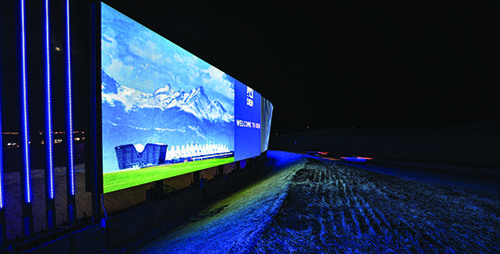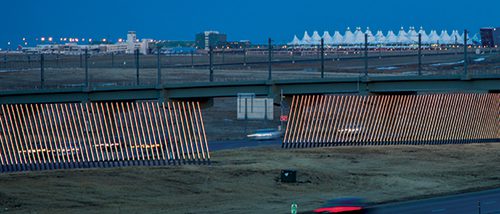When Denver International Airport (DEN) lays out the welcome mat, it goes all out. The largest and fifth-busiest airport in the United States now features a signature entry sign that stretches a quarter-mile long, with more than 900 LED-lighted poles that form a ribbon of moving light.
Three years in the making, DEN’s $11.5 million display is possibly the largest airport entry sign in the world. Designers invoked traditional Colorado images—rivers, mountains and rolling hills—when creating the iconic front entrance, says David Bruce, Facility Services manager for the airport.
The attention-grabbing display replaces the static backlit sign DEN installed before the Democratic National Convention in 2008, and is seen each day by arriving and departing passengers, riders aboard the city’s new light rail line and people in an estimated 120,000 vehicles on the nearby tollway.
“We are a gateway and front door to not only Denver, but the Colorado region,” says Heath Montgomery, the airport’s senior public information officer. “We wanted to create something people are really going to remember.”
Local Associate
|
facts&figures Project: LED Entry Sign Location: Denver Int’l Airport Visual Effect: Ribbon of moving light
Size: ¼-mile long; 3 LED signs, each 768 sq. ft.; Design & Installation: Panasonic Enterprise Solutions Cost: $11.5 million
Funding: $7 million from airport; $4.5 million
Maintenance & Operation Contract: Timeline: Idea developed in Sept. 2015; final design completed late 2016; installation completed Oct. 2017; sign went live early in Nov. 2017 |
The airport partnered on the project with Panasonic, which made a considerable local splash a few years ago by choosing to build the headquarters for its main U.S. innovation and sales hub (Panasonic Enterprise Solutions) in Denver. Plans for the company’s 400-acre development, located just 10 minutes from DEN, include 400 employees and a full “smart city,” complete with autonomous shuttles to the nearby light rail station. Local officials estimate the annual impact of the overall facility at $82 million, and Denver Mayor Michael Hancock said it could be the region’s biggest economic win in years.
Panasonic Enterprise Solutions was formed in 2014 as an umbrella organization for the company’s divisions that develop and sell large-scale digital signage, solar power systems, and audio- and visual-technology products and services. DEN worked with Panasonic’s CityNOW team to develop and install its new welcome sign, a micro-grid energy storage system and smart LED streetlights for the airport.
“We’ve always said from the beginning, we’re not going to just be a vendor in this,” explains John Greenwood, executive director of Digital City and Strategic Alliances for CityNOW. “The airport has always treated us like a partner. Three years later, we have something that everyone is proud to say was a joint, partnership-executed piece of art.”
 A Display Like No Other
A Display Like No Other
Concept planning for DEN’s new sign began in fall 2015. A whiteboard session with airport executives, the city mayor and Panasonic officials developed an initial drawing that is strikingly similar to what is standing in the ground today, notes Greenwood.
The project team spent four months in concept mode, and then dove into the design phase. Approval for the final design came in late 2016, and construction began in late spring the following year, after final permits were secured and clear weather materialized.
DEN and Panasonic personnel spent weeks building a mockup of 30 poles to ensure that LED lights would provide the desired visual effect and help determine what kind of graphics to use. “We really learned a lot from that,” Bruce recalls. “For myself, I was able to confirm that we were going to be able to build what the vision was—and that was critically important to us.”
 The mockup team fabricated 18-foot poles, painted them charcoal gray according to specifications for the final product and installed specially made LEDs from Hong Kong. After the sample system was complete, airport executives, Mayor Hancock, and representatives from Panasonic’s worldwide headquarters in Japan assessed the results.
The mockup team fabricated 18-foot poles, painted them charcoal gray according to specifications for the final product and installed specially made LEDs from Hong Kong. After the sample system was complete, airport executives, Mayor Hancock, and representatives from Panasonic’s worldwide headquarters in Japan assessed the results.
“We fired it up, got it lit and then we started playing around with graphics,” recalls Bruce. “We walked around to look at it from different viewing angles, because you don’t see it from a consistent angle when driving past—it’s always changing.”
The LEDs used to create the sign are good for 100,000 hours in a perfect environment, but Denver’s weather can be downright punishing. With wind gusts of 70 mph, 300 days of sunshine and multiple feet of snow stressing the sign’s components, Greenwood predicts that adjustments will need to be made after five to seven years.
The airport is responsible for maintaining the integrity of the electrical system that powers the sign and the grounds that surround it.
 Execution Was Everything
Execution Was Everything
One of the biggest challenges was making sure that contractors could actually build the system that the project team envisioned. That was also why the mockup was so vital, Bruce notes. “We spent a lot of time sweating the details to make sure when we broke ground it would be what everyone signed up for.”
Greenwood still marvels at the final outcome. “From an engineering perspective, this has never, ever been done,” he muses. “It’s incredible that we’re sitting here now and it’s working.”
Producing the poles that stand alongside the primary LED displays was particularly challenging, because they needed to curve at precise angles to create the display’s winding visual effect. Installers had to place each of the 908 poles perfectly, and every spot was surveyed to the finest detail, notes Bruce.
“They aren’t popsicle sticks,” Greenwood adds. “These things are huge.” Specifically, each of the poles has a 5-inch diameter and is 18 feet long, with 15 feet protruding above the ground.
H&H Metals, the local subcontractor that fabricated the poles, made significant contributions to the final system by calling weekly with ideas about how to make the poles better. “He would send us drawings, and I would pass them to our designer,” Bruce recalls. “They’ve been in the metal fabrication business for 30 years, knew what we needed to produce and understood the vision.”
All the contractors were fantastic to work with, and local vendors that already knew the airport environment were invaluable, he adds. “It was about more than just doing a job for a paycheck,” reflects Bruce. “It was an amazing experience for everyone.”
 Tactical Team Strategy
Tactical Team Strategy
Greenwood says that using the pillar approach, which emphasizes the importance of early stakeholder alignment, is was what made the unique project so successful. “If you don’t have that alignment in the beginning, it’s just an RFP [request for proposal] mentality,” he remarks.
Fostering unity was crucial from the original whiteboard session in September 2015 to the sign’s final debut in November 2017. Key stakeholders included representatives from DEN, the city, Panasonic and multiple real estate developers. “They needed to be humming the same tune, but also understand that it was not going to be ideal throughout the relationship,” Greenwood explains. He likens the project to a marriage: After the initial proposal was accepted, the team walked down the aisle together and then produced something everyone was proud of.
 The airport will run advertisements to help pay for the sign’s installation and $3 million, 12-year maintenance contract. It also uses the new display to alert visitors and local citizens about free arts and entertainment at DEN. The airport’s free ice-skating rink has been particularly popular since it opened in November 2016.
The airport will run advertisements to help pay for the sign’s installation and $3 million, 12-year maintenance contract. It also uses the new display to alert visitors and local citizens about free arts and entertainment at DEN. The airport’s free ice-skating rink has been particularly popular since it opened in November 2016.
Overall, the private/public partnership between DEN, the city and Panasonic has proved effective on many fronts. “We have an innovative technology leader basically on premises in a place that calls for sharing big ideas like this,” says Montgomery. “I don’t know of any other airport that has that.”
Greenwood agrees, noting that Panasonic was seriously considering five other major cities for its smart city project. “It was this partnership that allowed, and convinced us, to move to Denver,” he remarks.
Bruce hopes that more airports and cities come to understand how such projects can inspire economic growth. “We’re happy and proud to talk about it with our peers,” he says. “The sign came out exactly as envisioned, and I’m still amazed every time I look at it. I love driving past it every day.”



